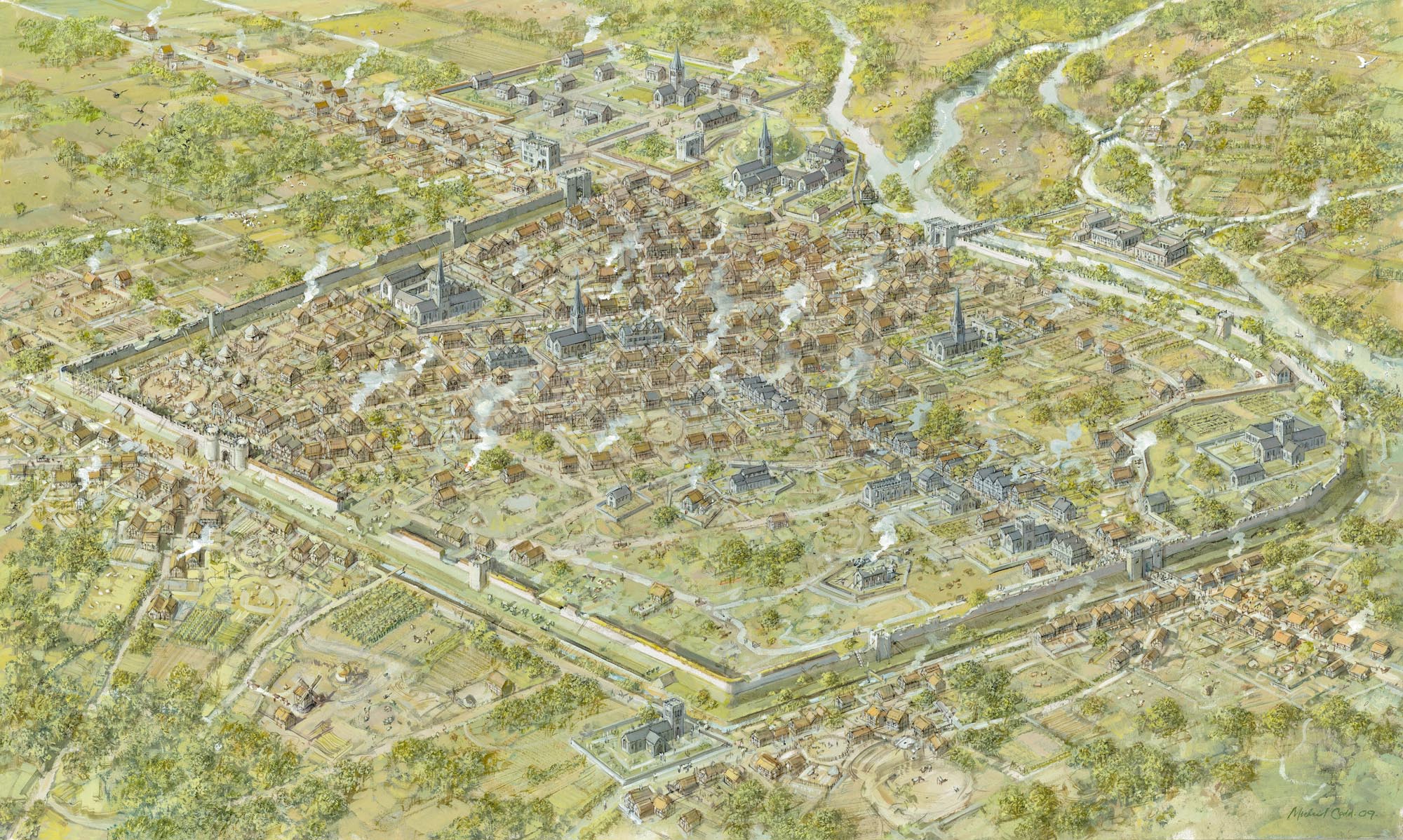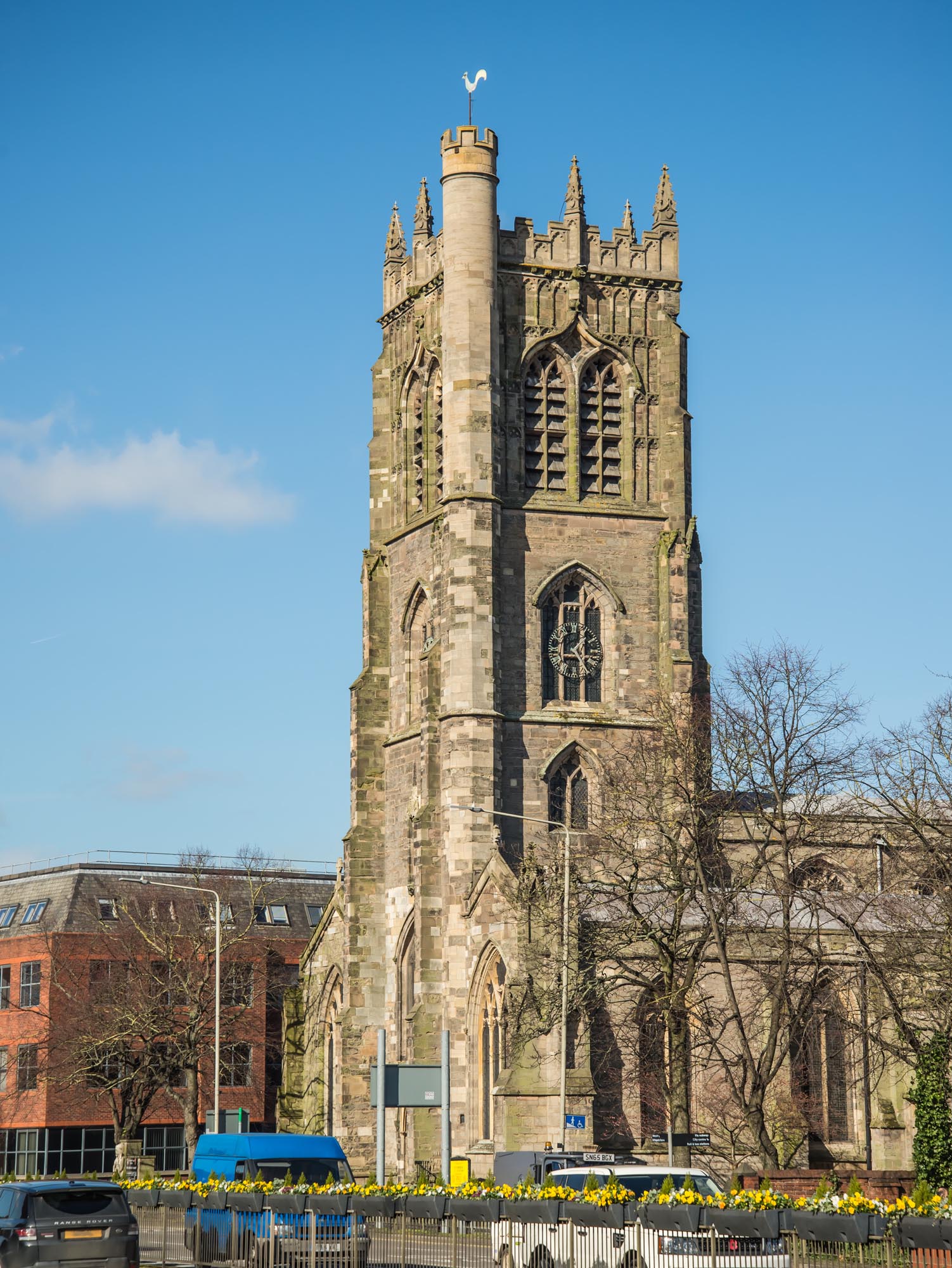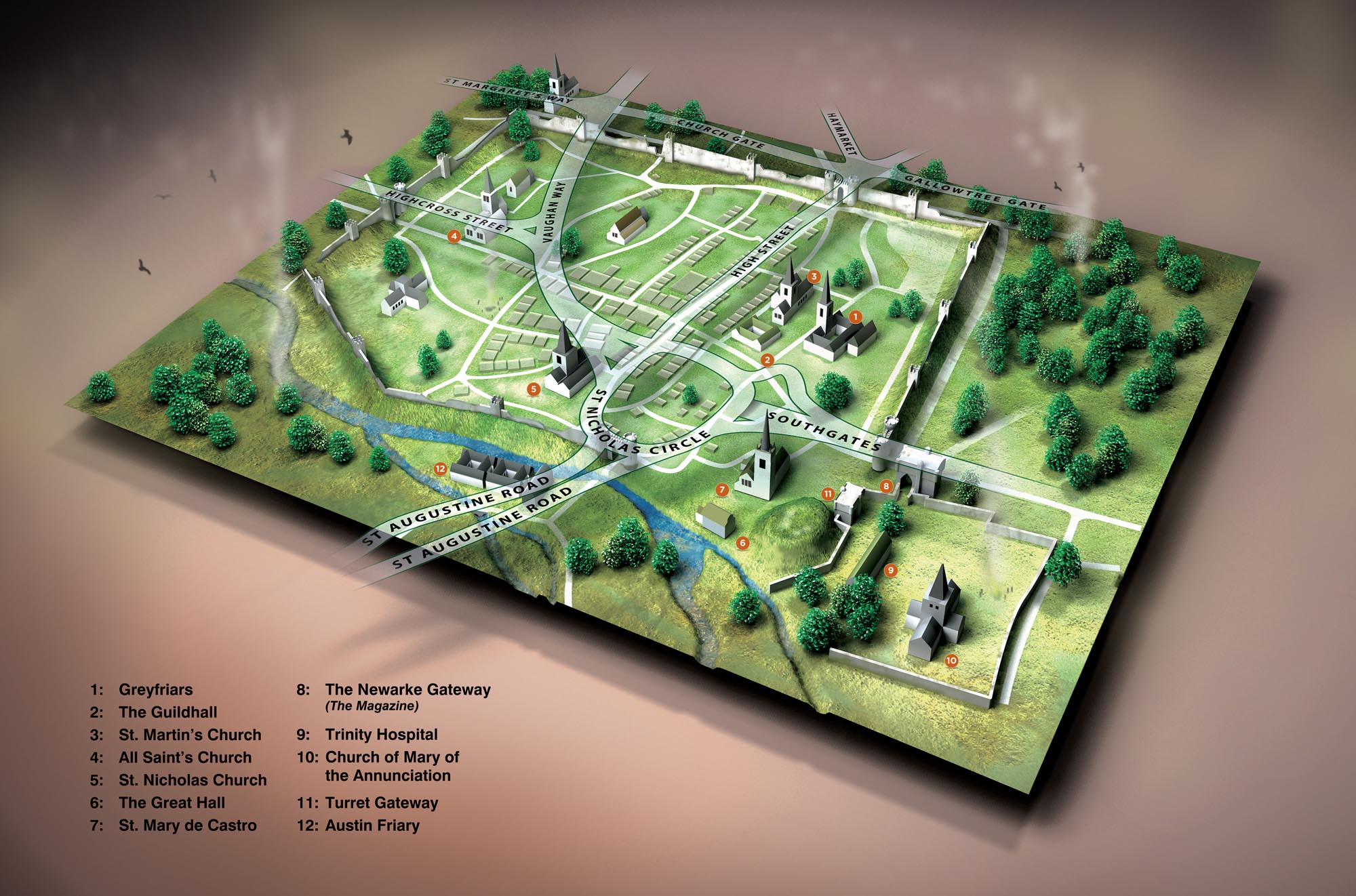- Medieval Leicester lay within the old Roman walls and its layout was heavily influenced by remaining Roman structures
- Gallowtree Gate was named after the road that led to the gallows
- Many of modern Leicester’s streets were established in medieval times and their names have medieval origins
What did Medieval Leicester look like?
Medieval Leicester’s Roman origins
Medieval Leicester lay within the old Roman walls. The town walls followed the lines of what are now Soar Lane, Sanvey Gate, Church Gate, Gallowtree Gate, Horsefair Street and Bath Lane in the west. Four fortress-like gates provided the main entrances into the town known as North Gate, East Gate, South Gate and West Gate. The Roman town walls were maintained throughout the medieval period, it was not until the later 15th century that they began to be pulled down and the stone reused for other purposes.
Until about the 13th century, the layout of streets and property boundaries was heavily influenced by the surviving remains of Roman structures. The medieval High Street, for example, respects the corner of the Roman forum, suggesting its walls were still visible. Other boundaries and medieval buildings appear to have used Roman walls as part of their construction.
Leicester at the time of the Norman Conquest
At the time of the Norman Conquest in 1066, Leicester was a thriving town with the Domesday Book of 1086 recording that there were 322 houses and six churches, suggesting a population of between 1500 and 2000.
The growth of medieval Leicester
In the 12th and 13th centuries, Leicester underwent a development boom. Several major new buildings appeared both inside and outside the town walls, including the friaries and Leicester Abbey, whilst many existing buildings, including the castle and the churches, were enlarged or rebuilt. In 1265 Leicester passed to a line of wealthy Lancastrian earls who undertook further ambitious building projects such as that of the Newarke, a religious precinct south of the castle.
The medieval High Street (now Highcross Street) was at this time the principal trading street of the town. The remains of what is thought to be a wealthy merchant’s house were found at the top of the modern Highcross Street under what is now the BBC building. It had an undercroft of stone which was probably used for the storage of valuable goods. The undercroft can still be seen through a glass floor inside the BBC Radio Leicester building.
Modern Leicester’s medieval origins
By 1450 many of the streets that still exist today had been established, together with most of the main plots. The area around Guildhall Lane, Loseby Lane and St Martins East and West still gives a good impression of what medieval Leicester might have looked like with its densely built-up narrow streets.
Modern Leicester’s medieval street names explained
Sanvey Gate – This is thought to be a corruption of Sancta Via (the Holy Way) and may have been a route for religious processions to St Margaret's Church.
Loseby Lane – This is named after Henry de Loseby, a local 14th-century landowner. The cattle market was held here in the middle ages.
Gallowtree Gate – This derives from the road ("gata") that leads to the gallows at the top of London Road.
Cank Street – It is thought this is named after the public well that lay there.
Butt Close Lane – The site of the town's archery butts.
Holy Bones – This name could be derived either from the discarded animal bones from the butchers trading close to St Nicholas Church or from the path leading to St Nicholas churchyard.
Friar Lane – The lane runs alongside the site of a Franciscan friary, occupied by friars who were called the "Grey Friars".
Gallery



Roman Leicester
(47- 500) A military fort was erected, attracting traders and a growing civilian community to Leicester (known as Ratae Corieltauvorum to the Romans). The town steadily grew throughout the reign of the Romans.
Medieval Leicester
(500 – 1500) The early years of this period was one of unrest with Saxon, Danes and Norman invaders having their influences over the town. Later, of course, came Richard III and the final battle of the Wars of the Roses was fought on Leicester’s doorstep.
-
The Castle Motte1068

-
Leicester Cathedral1086

-
St Mary de Castro1107

-
Leicester Abbey1138

-
Leicester Castle1150

-
Grey Friars1231

-
The Streets of Medieval Leicester1265

-
Leicester Market1298

-
Trinity Hospital and Chapel1330

-
Bow Bridgecirca 1350

-
Church of the Annunciation1353

-
John O’Gaunt’s Cellar1361

-
St John's Stone1381

-
Leicester Guildhall1390

-
The Magazine1400

-
The Blue Boar Inn1400

-
The High Cross1577

Tudor & Stuart Leicester
(1500 – 1700) The wool trade flourished in Leicester with one local, a former mayor named William Wigston, making his fortune. During the English Civil War a bloody battle was fought as the forces of King Charles I laid siege to the town.
Georgian Leicester
(1700 – 1837) The knitting industry had really stared to take hold and Leicester was fast becoming the main centre of hosiery manufacture in Britain. This new prosperity was reflected throughout the town with broader, paved streets lined with elegant brick buildings and genteel residences.
-
Great Meeting Unitarian Chapel1708

-
The Globe1720

-
17 Friar Lane1759

-
Black Annis and Dane Hills1764

-
Leicester Royal Infirmary1771

-
New Walk1785

-
Freemasons’ Hall1790

-
Gaols in the City1791

-
Friars Mill1794

-
City Rooms1800

-
Development of Highfields1800

-
Wesleyan Chapel1815

-
20 Glebe Street1820

-
Charles Street Baptist Chapel1830

-
Glenfield Tunnel1832

-
James Cook1832

Victorian Leicester
(1837 – 1901) The industrial revolution had a huge effect on Leicester resulting in the population growing from 40,000 to 212,000 during this period. Many of Leicester's most iconic buildings were erected during this time as wealthy Victorians made their mark on the town.
-
Leicester Union Workhouse1839

-
Campbell Street and London Road Railway Stations1840

-
The Vulcan Works1842

-
Belvoir Street Chapel1845

-
Welford Road Cemetery1849

-
Leicester Museum & Art Gallery1849

-
King Street1850

-
Cook’s Temperance Hall & Hotel1853

-
Amos Sherriff1856

-
Weighbridge Toll Collector’s House1860

-
4 Belmont Villas1862

-
Top Hat Terrace1864

-
Corah and Sons - St Margaret's Works1865

-
Kirby & West Dairy1865

-
The Clock Tower1868

-
Wimbledon Works1870

-
The Leicestershire Banking Company1871

-
St Mark’s Church and School1872

-
Victorian Turkish Baths1872

-
The Town Hall1876

-
Central Fire Stations1876

-
Aylestone Road Gas Works and Gas Museum1879

-
Gas Workers Cottages1879

-
Leicestershire County Cricket Club1879

-
Welford Road Tigers Rugby Club1880

-
Secular Hall1881

-
Development of Highfields1800

-
Abbey Park1881

-
Abbey Park Buildings1881

-
Victoria Park and Lutyens War Memorial1883

-
Leicester Fosse FC 18841884

-
Leicester Coffee and Cocoa Company Coffee Houses1885

-
St Barnabas Church and Vicarage1886

-
Abbey Pumping Station1891

-
Luke Turner & Co. Ltd.1893

-
West Bridge Station1893

-
Thomas Cook Building1894

-
The White House1896

-
Alexandra House1897

-
Leicester Boys Club1897

-
Grand Hotel and General Newsroom1898

-
Highfield Street Synagogue1898

-
Western Park1899

-
Asfordby Street Police Station1899

-
Leicester Central Railway Station1899

Edwardian Leicester
(1901 – 1910) Electric trams came to the streets of Leicester and increased literacy among the citizens led to many becoming politicised. The famous 1905 ‘March of the Unemployed to London’ left from Leicester market when 30,000 people came to witness the historic event.
-
YMCA Building1900

-
The Palace Theatre1901

-
Pares's Bank1901

-
Coronation Buildings1902

-
Halfords1902

-
High Street1904

-
George Biddles and Leicester's Boxing Heritage1904

-
Municipal Library1905

-
Leicester Boys Club1897

-
The Marquis Wellington1907

-
Guild Hall Colton Street1909

-
Women's Social and Political Union Shop1910

-
Turkey Café1901

Early 20th Century Leicester
(1910 – 1973) The diverse industrial base meant Leicester was able to cope with the economic challenges of the 1920s and 1930s. New light engineering businesses, such as typewriter and scientific instrument making, complemented the more traditional industries of hosiery and footwear manufacturing.
-
Dryad Handicrafts1912

-
De Montfort Hall1913

-
Leicester During the First World War1914

-
Fox’s Glacier Mints1918

-
Statue of Liberty1919

-
Housing in Saffron Lane1924

-
Winstanley House1925

-
Housing in North Braunstone1926

-
Lancaster Road Fire Station1927

-
The Little Theatre1930

-
Saffron Hill Cemetery1931

-
Braunstone Hall Junior School1932

-
Former City Police Headquarters1933

-
Savoy Cinema1937

-
Eliane Sophie Plewman1937
-
City Hall1938

-
Athena - The Odeon Cinema1938

-
The Blitz in Highfields1940

-
Freeman, Hardy and Willis - Leicester Blitz1940

-
Leicester Airport1942

-
Leicester’s Windrush Generations1948

-
Netherhall Estate1950
-
Housing at Eyres Monsell1951

-
Silver Street and The Lanes1960

-
Bostik1960

-
Auto-Magic Car Park (Lee Circle)1961

-
University of Leicester Engineering Building1963

-
Sue Townsend Theatre1963

-
Central Mosque1968

-
Belgrave Flyover1973

Modern Leicester
(1973 – present day) Industry was still thriving in the city during the 1970s, with the work opportunities attracting many immigrants from all over the world. While industry has declined in recent years, excellent transport links have made Leicester an attractive centre for many businesses. The City now has much to be proud of including its sporting achievements and the richness of its cultural heritage and diversity.
-
Haymarket Theatre1973

-
The Golden Mile1974

-
Acting Up Against AIDS1976

-
Belgrave Neighbourhood Centre1977

-
Diwali in Leicester1983

-
Leicester Caribbean Carnival1985

-
Samworth Brothers1986

-
Jain Centre1988

-
Guru Nanak Dev Ji Gurdwara1989

-
King Power Stadium2002

-
LCB Depot2004

-
Curve2008

-
BAPS Shri Swaminarayan Mandir2011

-
Makers Yard2012

- Roman Leicester
- Medieval Leicester
- Tudor & Stuart Leicester
- Georgian Leicester
- Victorian Leicester
- Edwardian Leicester
- Early 20th Century Leicester
- Modern Leicester
A Place to Live















































































































































